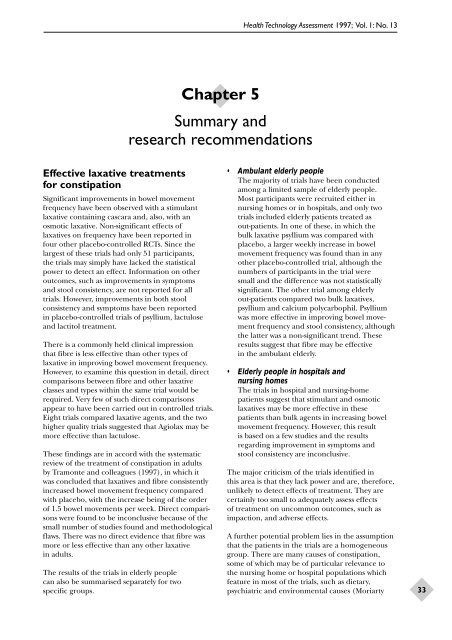Effectiveness of Laxatives in the Elderly - NIHR Health Technology ...
Effectiveness of Laxatives in the Elderly - NIHR Health Technology ...
Effectiveness of Laxatives in the Elderly - NIHR Health Technology ...
You also want an ePaper? Increase the reach of your titles
YUMPU automatically turns print PDFs into web optimized ePapers that Google loves.
Effective laxative treatments<br />
for constipation<br />
Significant improvements <strong>in</strong> bowel movement<br />
frequency have been observed with a stimulant<br />
laxative conta<strong>in</strong><strong>in</strong>g cascara and, also, with an<br />
osmotic laxative. Non-significant effects <strong>of</strong><br />
laxatives on frequency have been reported <strong>in</strong><br />
four o<strong>the</strong>r placebo-controlled RCTs. S<strong>in</strong>ce <strong>the</strong><br />
largest <strong>of</strong> <strong>the</strong>se trials had only 51 participants,<br />
<strong>the</strong> trials may simply have lacked <strong>the</strong> statistical<br />
power to detect an effect. Information on o<strong>the</strong>r<br />
outcomes, such as improvements <strong>in</strong> symptoms<br />
and stool consistency, are not reported for all<br />
trials. However, improvements <strong>in</strong> both stool<br />
consistency and symptoms have been reported<br />
<strong>in</strong> placebo-controlled trials <strong>of</strong> psyllium, lactulose<br />
and lactitol treatment.<br />
There is a commonly held cl<strong>in</strong>ical impression<br />
that fibre is less effective than o<strong>the</strong>r types <strong>of</strong><br />
laxative <strong>in</strong> improv<strong>in</strong>g bowel movement frequency.<br />
However, to exam<strong>in</strong>e this question <strong>in</strong> detail, direct<br />
comparisons between fibre and o<strong>the</strong>r laxative<br />
classes and types with<strong>in</strong> <strong>the</strong> same trial would be<br />
required. Very few <strong>of</strong> such direct comparisons<br />
appear to have been carried out <strong>in</strong> controlled trials.<br />
Eight trials compared laxative agents, and <strong>the</strong> two<br />
higher quality trials suggested that Agiolax may be<br />
more effective than lactulose.<br />
These f<strong>in</strong>d<strong>in</strong>gs are <strong>in</strong> accord with <strong>the</strong> systematic<br />
review <strong>of</strong> <strong>the</strong> treatment <strong>of</strong> constipation <strong>in</strong> adults<br />
by Tramonte and colleagues (1997), <strong>in</strong> which it<br />
was concluded that laxatives and fibre consistently<br />
<strong>in</strong>creased bowel movement frequency compared<br />
with placebo, with <strong>the</strong> <strong>in</strong>crease be<strong>in</strong>g <strong>of</strong> <strong>the</strong> order<br />
<strong>of</strong> 1.5 bowel movements per week. Direct comparisons<br />
were found to be <strong>in</strong>conclusive because <strong>of</strong> <strong>the</strong><br />
small number <strong>of</strong> studies found and methodological<br />
flaws. There was no direct evidence that fibre was<br />
more or less effective than any o<strong>the</strong>r laxative<br />
<strong>in</strong> adults.<br />
The results <strong>of</strong> <strong>the</strong> trials <strong>in</strong> elderly people<br />
can also be summarised separately for two<br />
specific groups.<br />
Chapter 5<br />
Summary and<br />
research recommendations<br />
<strong>Health</strong> <strong>Technology</strong> Assessment 1997; Vol. 1: No. 13<br />
• Ambulant elderly people<br />
The majority <strong>of</strong> trials have been conducted<br />
among a limited sample <strong>of</strong> elderly people.<br />
Most participants were recruited ei<strong>the</strong>r <strong>in</strong><br />
nurs<strong>in</strong>g homes or <strong>in</strong> hospitals, and only two<br />
trials <strong>in</strong>cluded elderly patients treated as<br />
out-patients. In one <strong>of</strong> <strong>the</strong>se, <strong>in</strong> which <strong>the</strong><br />
bulk laxative psyllium was compared with<br />
placebo, a larger weekly <strong>in</strong>crease <strong>in</strong> bowel<br />
movement frequency was found than <strong>in</strong> any<br />
o<strong>the</strong>r placebo-controlled trial, although <strong>the</strong><br />
numbers <strong>of</strong> participants <strong>in</strong> <strong>the</strong> trial were<br />
small and <strong>the</strong> difference was not statistically<br />
significant. The o<strong>the</strong>r trial among elderly<br />
out-patients compared two bulk laxatives,<br />
psyllium and calcium polycarbophil. Psyllium<br />
was more effective <strong>in</strong> improv<strong>in</strong>g bowel movement<br />
frequency and stool consistency, although<br />
<strong>the</strong> latter was a non-significant trend. These<br />
results suggest that fibre may be effective<br />
<strong>in</strong> <strong>the</strong> ambulant elderly.<br />
• <strong>Elderly</strong> people <strong>in</strong> hospitals and<br />
nurs<strong>in</strong>g homes<br />
The trials <strong>in</strong> hospital and nurs<strong>in</strong>g-home<br />
patients suggest that stimulant and osmotic<br />
laxatives may be more effective <strong>in</strong> <strong>the</strong>se<br />
patients than bulk agents <strong>in</strong> <strong>in</strong>creas<strong>in</strong>g bowel<br />
movement frequency. However, this result<br />
is based on a few studies and <strong>the</strong> results<br />
regard<strong>in</strong>g improvement <strong>in</strong> symptoms and<br />
stool consistency are <strong>in</strong>conclusive.<br />
The major criticism <strong>of</strong> <strong>the</strong> trials identified <strong>in</strong><br />
this area is that <strong>the</strong>y lack power and are, <strong>the</strong>refore,<br />
unlikely to detect effects <strong>of</strong> treatment. They are<br />
certa<strong>in</strong>ly too small to adequately assess effects<br />
<strong>of</strong> treatment on uncommon outcomes, such as<br />
impaction, and adverse effects.<br />
A fur<strong>the</strong>r potential problem lies <strong>in</strong> <strong>the</strong> assumption<br />
that <strong>the</strong> patients <strong>in</strong> <strong>the</strong> trials are a homogeneous<br />
group. There are many causes <strong>of</strong> constipation,<br />
some <strong>of</strong> which may be <strong>of</strong> particular relevance to<br />
<strong>the</strong> nurs<strong>in</strong>g home or hospital populations which<br />
feature <strong>in</strong> most <strong>of</strong> <strong>the</strong> trials, such as dietary,<br />
psychiatric and environmental causes (Moriarty<br />
33
















